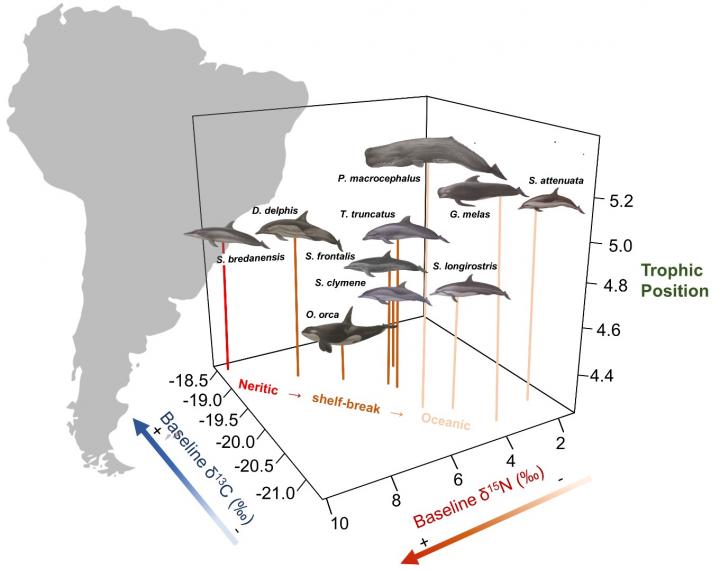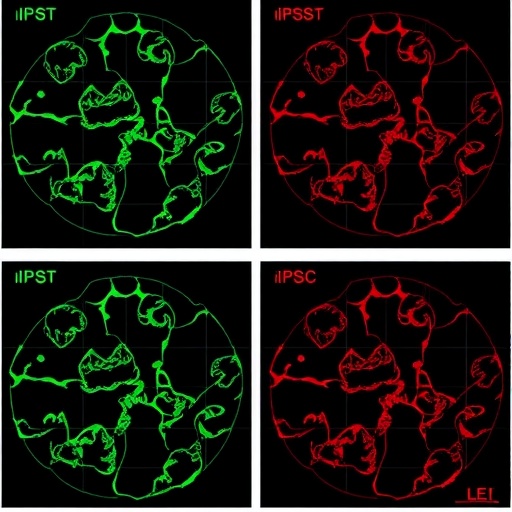
Credit: Image: Genyffer C. Troina. Cetacean illustration by José Luis Vázquez, adapted from Bastida et al. 2018
Dolphin species that live together, do not necessarily compete for food
A new molecular method reveals how different species of toothed whales compete for prey and which food they choose in each other’s company. Marine scientists from NIOZ recently published their work in the scientific magazine Environmental Research.
Little is still known about the food and food search behaviour of toothed whales. What we know historically, is primarily derived from the stomach content of dead specimens. However, this makes it hard to actively study them in their natural habitat: you can’t do more than wait for animals to wash ashore. Consequently, proper ecological research on how various species of sea mammals influence one another in their choice for food, is quite difficult, as you cannot observe the animals at the large depths at which they hunt.
Neither top predator nor overlap in food
For this problem, researchers of the Royal NIOZ, Netherlands Institute for Sear Research, found a solution. They used so-called stable nitrogen isotopes of amino acids in small pieces of skin tissue from living sperm whales, orca and eight dolphin species in the Southwestern part of the Atlantic Ocean, off the coast of Brazil.
“It was known that there were slight differences in food preference in for example fish or squid”, says researcher Marcel van der Meer. “However, according to previous research, the rough-toothed dolphin Steno bredanensis was supposed to be the absolute top predator of the area, and that is unlikely. With our amino acid isotope research, we discovered that its trophic level is indeed significantly lower than previously determined.”
Apart from that, the method used before, suggested great overlap in food of three of the dolphin species. Van der Meer “We now know that there isn’t any overlap whatsoever. The short-beaked common dolphin Delphinus delphis, turns out to hunt at a different depth in shallow water, while the Atlantic spotted dolphin Stenella frontalis and the common bottlenose dolphin Tursiops truncatus hunt in waters up to depths of 500 meters. The latter two species, that thus feed at the same depth, have different prey. Apparently, the dolphin species have found a way to live together without competing for food.
Correcting for the noise
In this research project, first author Genyffer Troina (Federal University of Rio Grande, Brazil) visited the NIOZ on Texel to work on her samples with Marcel van der Meer and his colleague Philip Riekenberg. It is an improvement of more commonly used isotope analysis (see frame), however uses nitrogen in free amino acids instead of in the tissue as a whole. They use the nitrogen isotopes of the amino acid phenylalanine, a building block of every living cell that, after uptake by plant eaters, is passed through the food web almost unchanged up to the level of top predators.
Using the nitrogen isotope value of this amino acid, the scientists can, as it were, determine the base value of the nitrogen in the environment. That enables them to correct for the ‘noise’ that is caused by an unknown living environment in which researchers cannot measure the nitrogen value themselves. By comparing the base value with the value in the sea mammal they are studying, they are able to determine the trophic level of the species, meaning what its position is in taking up the amino acids. A plant would be level one, a top predator may be level 5.
Research with stable isotopes goes roughly like this. A small part of the atoms like nitrogen (N) that occur in every living cell, is a little bit heavier than the rest. As an animal ingests the nitrogen with its food, digestion (metabolism) separates the heavy atoms a tiny bit slower than the light ones, with the result that the heavy atoms are taken up into the body tissue of the animal more often than the light version. This pattern of uptake piles up: the higher an animal is in the food web, the more heavy N-atoms in its body tissue.
However, to be able to guarantee the accuracy of the method, you must know the isotope level of the original food. In marine environments, this value – most often of algae – is difficult to determine and may also vary a lot. The amino acid isotope method solves that problem.
#
Media Contact
Marcel van der Meer
[email protected]
Original Source
https:/
Related Journal Article
http://dx.




